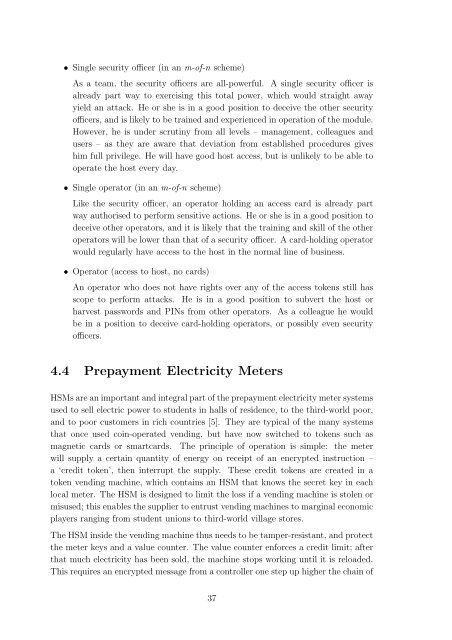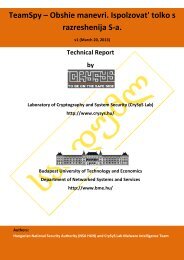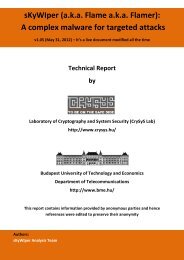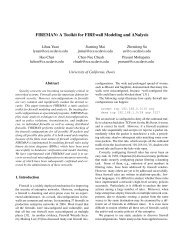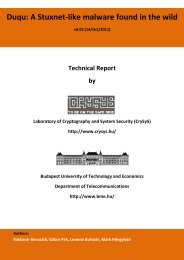Understanding Security APIs - CrySyS Lab
Understanding Security APIs - CrySyS Lab
Understanding Security APIs - CrySyS Lab
You also want an ePaper? Increase the reach of your titles
YUMPU automatically turns print PDFs into web optimized ePapers that Google loves.
• Single security officer (in an m-of-n scheme)<br />
As a team, the security officers are all-powerful. A single security officer is<br />
already part way to exercising this total power, which would straight away<br />
yield an attack. He or she is in a good position to deceive the other security<br />
officers, and is likely to be trained and experienced in operation of the module.<br />
However, he is under scrutiny from all levels – management, colleagues and<br />
users – as they are aware that deviation from established procedures gives<br />
him full privilege. He will have good host access, but is unlikely to be able to<br />
operate the host every day.<br />
• Single operator (in an m-of-n scheme)<br />
Like the security officer, an operator holding an access card is already part<br />
way authorised to perform sensitive actions. He or she is in a good position to<br />
deceive other operators, and it is likely that the training and skill of the other<br />
operators will be lower than that of a security officer. A card-holding operator<br />
would regularly have access to the host in the normal line of business.<br />
• Operator (access to host, no cards)<br />
An operator who does not have rights over any of the access tokens still has<br />
scope to perform attacks. He is in a good position to subvert the host or<br />
harvest passwords and PINs from other operators. As a colleague he would<br />
be in a position to deceive card-holding operators, or possibly even security<br />
officers.<br />
4.4 Prepayment Electricity Meters<br />
HSMs are an important and integral part of the prepayment electricity meter systems<br />
used to sell electric power to students in halls of residence, to the third-world poor,<br />
and to poor customers in rich countries [5]. They are typical of the many systems<br />
that once used coin-operated vending, but have now switched to tokens such as<br />
magnetic cards or smartcards. The principle of operation is simple: the meter<br />
will supply a certain quantity of energy on receipt of an encrypted instruction –<br />
a ‘credit token’, then interrupt the supply. These credit tokens are created in a<br />
token vending machine, which contains an HSM that knows the secret key in each<br />
local meter. The HSM is designed to limit the loss if a vending machine is stolen or<br />
misused; this enables the supplier to entrust vending machines to marginal economic<br />
players ranging from student unions to third-world village stores.<br />
The HSM inside the vending machine thus needs to be tamper-resistant, and protect<br />
the meter keys and a value counter. The value counter enforces a credit limit; after<br />
that much electricity has been sold, the machine stops working until it is reloaded.<br />
This requires an encrypted message from a controller one step up higher the chain of<br />
37


